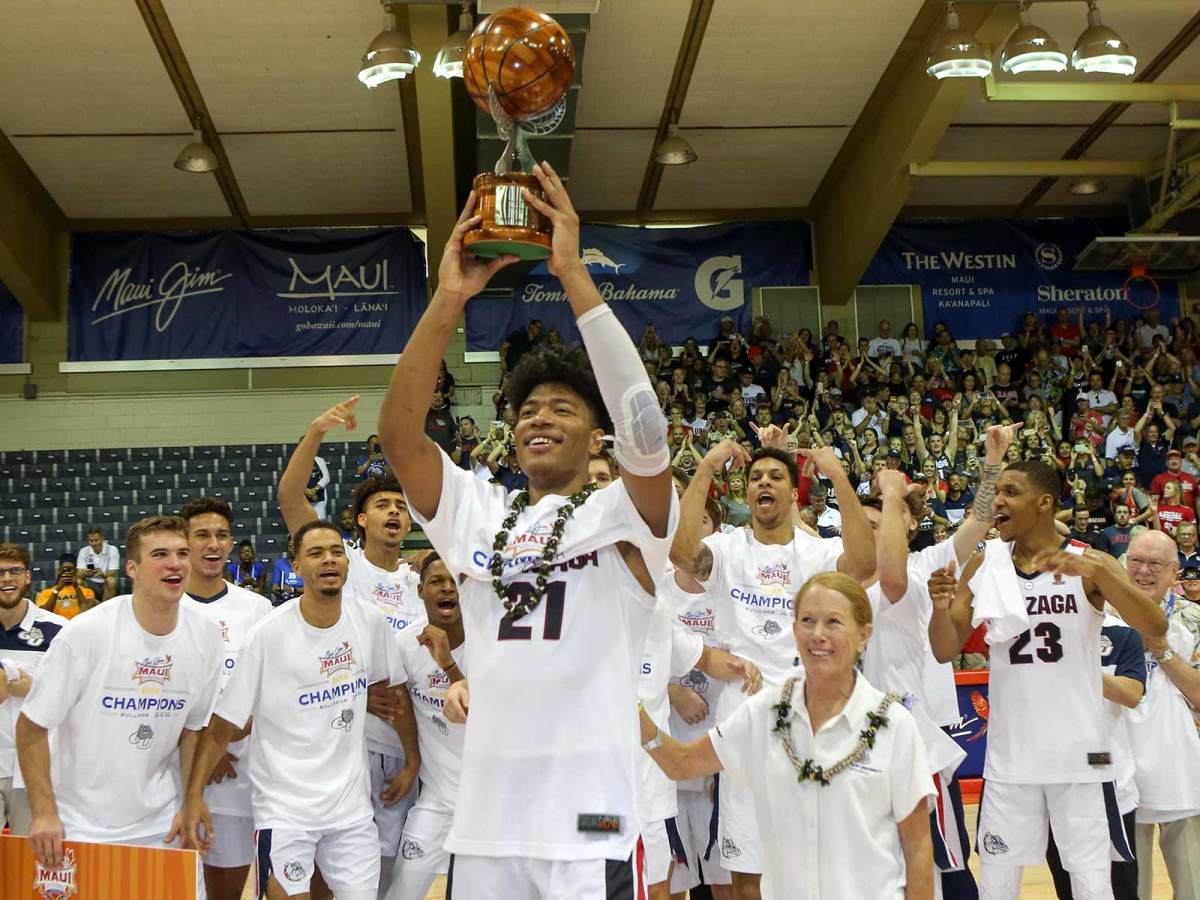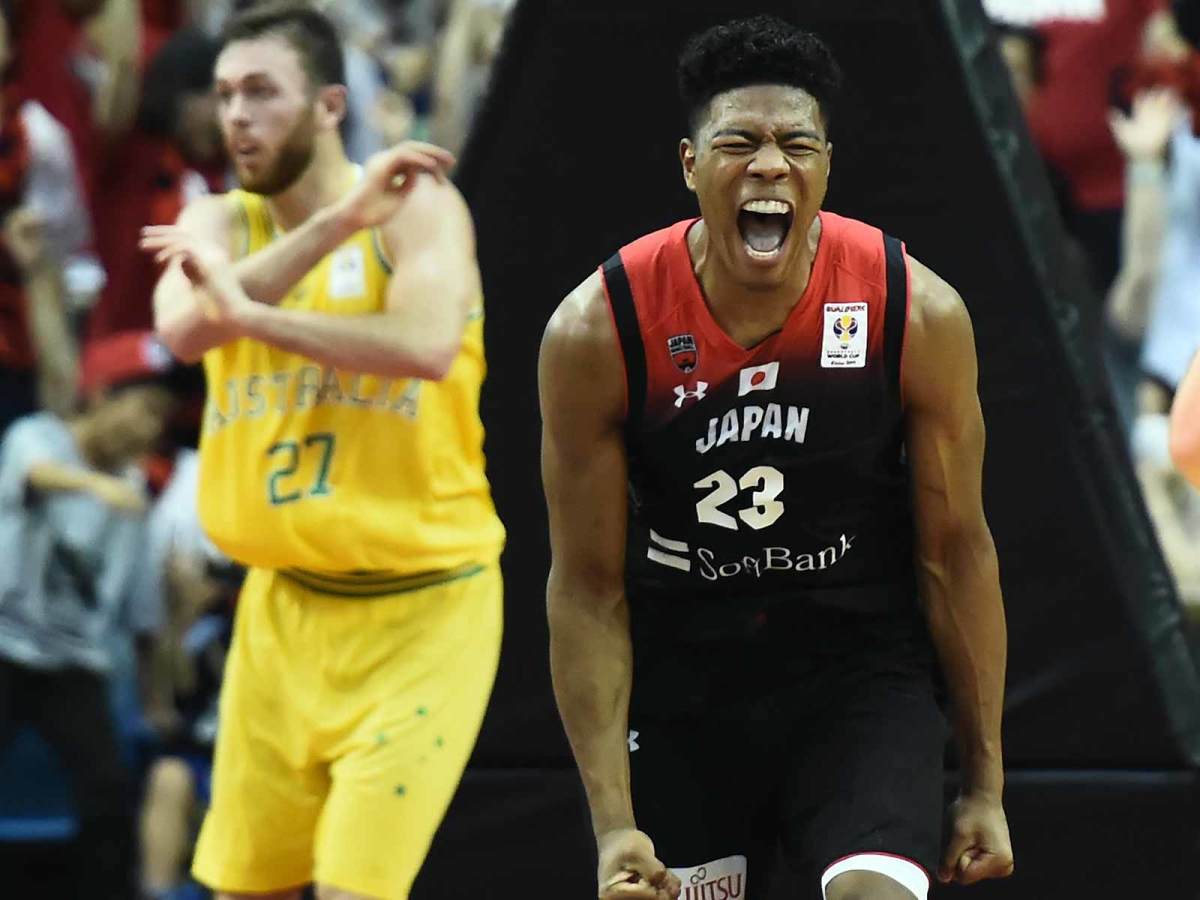Rui Hachimura Is Thriving as Japan and Gonzaga's Best Hope for Basketball Glory

Rui Hachimura is a big deal at Gonzaga, and not just because of the 21.9 points he’s averaging for the No. 1 ranked Bulldogs. Every time the 6'8" forward visits the school’s English Language Center, the building buzzes with the entrance of the superstar. Less than three years ago, Hachimura arrived from Japan with a very limited grasp of English. Now, he’s practically fluent—and particularly fond of dropping f-bombs.
On a sunny day in early October, the center’s faculty invited Hachimura to speak to beginner students to model what can be accomplished through hard work and study. The story of Hachimura’s linguistic success at the center has already crossed borders. “I went to Japan to recruit,” says Li Yang, the program’s director. “And I had students coming up to me, saying, ‘I know I can’t play basketball as well as Rui, but I want to speak English as well as him.’”
Upon entering the center, a squat, cramped collection of rooms on the bottom floor of Welch Hall, an all-female residence for first- and second-year students, Hachimura is given a blue ELC T-shirt, which he slips on over his gray Gonzaga sweats before folding himself into a tiny chair at the front of a tiny classroom in the basement. There are 11 students in their first year in the program, from Japan, Saudi Arabia and Italy. The assignment: Ask Hachimura basic questions in English. One student asks about Hachimura’s biggest fears. (Animals, and he particularly dislikes squirrels.) Another asks about his favorite NBA team. (The Spurs.) After about 10 minutes of questions, Hachimura is led upstairs to a photo shoot in the lobby, where he and five Japanese students take a picture draped in their country's flag. After nearly three years in the U.S., Hachimura has conquered the English language. And to start his junior season, Hachimura has helped vanquish every team the Zags have faced, including at the Maui Invitational, where he was named MVP. He scored 23 points against Illinois; had 24 points on 10-of-16 shooting against Arizona; and keyed the Zags’ 89–87 upset of Duke. Playing against a Blue Devils team teeming with five-star freshmen, Hachimura was the game’s most impressive player, scoring 20 points and preventing potential No.1 NBA draft pick R.J. Barrett from tying the score in the final seconds.
“I think he [switched] on me, he likes to play one-on-one against me,” Hachimura told reporters after the game. “I was like, ‘O.K., let’s do it. I’m the best player, too.’”

It’s tough to say where basketball ranks in Japan in terms of popularity, but it’s definitely not first. That title belongs to baseball. Even Hachimura, the son of a Beninese father and Japanese mother, didn’t start playing basketball right away. He played baseball, and only tried basketball after a friend nagged him. He was 13, and 5'5"—which, while not necessarily a sign that he would grow to 6'8", isn’t far below the average male height in the country (5'7").
Three years later, in 2014, Hachimura was competing at the U-17 World Championships in Dubai. Japan finished 14th out of 16 teams—but Hachimura was dominant. In a competition that featured future NBAers such as Jayson Tatum (11.3 ppg), Harry Giles (10.9 ppg) and Josh Jackson (10.6 ppg), Hachimura outplayed them all, averaging a tournament-best 22.6 points. Although Japan was destroyed by the U.S. 122–38, Hachimura had 25 points.
“I had never seen a player in Asia like this before,” says Gonzaga assistant coach Tommy Lloyd. The performance in Dubai was the first time Lloyd had seen or heard of Hachimura. “The raw talent was evident. You saw the traits. He had this body that you knew was going to blow up as he started lifting weights.”
Before Hachimura, there had only been four players from Japan in Division I. Only one Japanese player had ever made the NBA—Yuta Tabuse, who played four games for the Suns in 2004–05. While Japanese basketball is competitive, it’s a completely different style than what is played in America. “In Japan, we kind of play, [like], whatever,” says Hachimura. “Here, you really have to, not kill people, but be aggressive.”
He toured both Gonzaga and Arizona—and says he chose the Zags in part because Spokane reminded him of his hometown of Toyoma, a coastal town about a five-hour drive west of Tokyo. And Gonzaga has a long history of international players thriving, making the cultural and basketball transition he’d have to make less daunting.
The Gonzaga basketball program has been scouring the globe for talent since the summer of 1957, when a 7'3" Parisian arrived in Spokane. The son of a farmer, and with limited English skills, Jean Claude Lefebvre had only played basketball for a few years before he came to the U.S. Lefebvre was somewhat of a national sensation—SI dispatched a writer to campus just three months later. Jerry O’Brien, the author, liked what he saw in Lefebvre, quoting a coach who said the Frenchman “could be the greatest basketball player in the world.” O’Brien added that Lefebvre’s “arrival in Spokane ... may well have given birth to a new dimension in basketball recruiting and brought an end to isolationist thinking among domestic proselytizers.”
Known as the Eiffel Rifle, Lefebvre played just two years for the Zags. He averaged 14.5 points as a freshman, but a knee injury as a sophomore limited his playing time and production. He was drafted by the Minneapolis Lakers in the ninth round in 1960, but turned down the NBA in order to train for the Olympics that year. He contracted tuberculosis, however, and didn’t compete in the Rome Games.
Gonzaga has relied on foreign players to become a national powerhouse. John Rillie, a guard from Australia, led the Zags to their first NCAA tournament appearance in 1995. The run to the Elite Eight in 1999 featured players from the Bahamas and Australia. Ronny Turiaf, the 10-year NBA vet and French national who longtime athletic director Mike Roth calls the “mayor of Spokane,” was the conference player of the year in 2005. J.P. Batista (Brazil), Kelly Olynyk, Robert Sacre, Kevin Pangos (Canada), Elias Harris (Germany) and Domantas Sabonis (Lithuania) are just a few of the recent international stars. On this year’s roster, four players were born abroad. Hachimura is only the next in line.
“It starts with a phone call,” says Lloyd, who serves as the lead recruiter for international players, and who went to Argentina, Latvia and Mexico this year to scout talent. “There’s no infrastructure. But having had so many international players, it becomes comfortable for a lot of players.”
After seeing Hachimura play in the U-17 championships in Dubai, Lloyd called Meisei High in Sendai, Japan to begin the recruiting process. “We get a lot of tapes,” says Gonzaga coach Mark Few. “And here’s a guy from Japan. But then you put your eyes on him, you’re like whoa. It was like, O.K., we better look into it.”
“It’s easier for us to recruit now,” says Roth. “In France, we have Killian Tillie here, and Joel Ayayi. Go all the way back to Turiaf. We’ll continue to have inroads into Germany because of Elias. Or take Domas in Lithuania. If I’m a parent or young man in Lithuania, I see that path that Sabonis took to be the 11th pick in the draft.”
Most international students come with a pretty good grasp of English. “In every instance, a foreign education system is farther along than what [the U.S.] doing,” says Few. “All of them speak multiple languages, they pick up stuff real quick. Rui was the first real language problem. He was absorbing 10% of what we were saying.”
When Hachimura arrived on campus in May, 2016, he was placed in the Global Bridge program, which helps students meet the school’s English proficiency requirements. Hachimura was in class for about five to six hours a day. He took classes such as a communication and speech, which focuses on listening skills and public speaking.
An admittedly disinterested student, Hachimura struggled at first. But his perseverance was notable. He discovered two new favorite books—Animal Farm, and The Absolutely True Diary of a Part Time Indian—and is enjoying classes in his major of sport management.
“I’m blown away by what he’s been able to accomplish,” says Steffany Galbraith, his academic advisor. “I think he was a little shocked when he got here, especially in that fall semester. But he took everything in stride. He’s made tremendous steps forward.”
Hachimura has become quite proficient in English. During his freshman season, the team went on a retreat, and there was a guest speaker. Ken Nakagawa, the team’s video coordinator, is fluent in Japanese and served as Hachimura’s translator. “I asked him if he understood anything, and he was like, maybe 10%.” Last year, though, at another retreat, a different speaker asked him a question. “And Rui answered back perfectly,” Nakagawa says. “I was like, this is the best moment. All this is paying off.”
Idiomatic expressions are still a struggle, however. Once, when filling out forms, Galbraith asked Hachimura if he had “butterflies in his stomach.” Googling the phrase made him even more confused. When Few, who has encouraged Hachimura to get tougher on the court, told his player that he looks like a little kid at a pillow fight, Hachimura had no idea what a pillow fight was. “There’s still examples like that,” Few says. “But he’s really so much better with understanding what we’re doing.”
As Hachimura got more comfortable off the court, he made huge strides on it. After a freshman year in which he averaged fewer than five minutes a game—there was a glut of forwards ahead of him on that Final Four team, plus, as Few says, they had to “get him to be a little nasty”—Hachimura thrived with more playing time as a sophomore. He averaged 11.6 points in only 20 minutes and broke out with 25 points in the second round of the NCAA tournament against Ohio State. He earned first-team all-conference honors. He was mentioned as a possible NBA first-round pick. Now he gets the chance to further hone his game and experience life as the main threat on a title contender. “I keep on him about owning it,” Few says. “Owning the moment, owning the possession. Not deferring. He needs to call his own number.”
An elite mid-range shooter who excels in transition and is capable of guarding all positions, Hachimura is mastering all facets of the game. Last season, against St. Mary’s, Few stuck Hachimura on 6'1" point guard Emmett Naar, who was second in the nation in assists, and Hachimura shut him down. There’s not much he can’t do on the court.
“He’s very effective in the high post,” says a WCC assistant coach. “He’s an animal on the glass. I mean, he only played half the game last year! He’s one of the favorites for best player in the conference.”

For all his popularity on campus, Hachimura is even more widely recognized in his native Japan, where Rui-mania has taken hold. At his high school, where he won three straight championships, fans in the stands would wear T-shirts with his face on them. Hordes of Japanese media have descended to the West Coast Conference championships in Las Vegas, and to games in Spokane. During qualifying for the FIBA World Cup this past May, the Japanese Basketball Association (JBA) took out a full-page ad in a national newspaper with his picture. Above his frame were the words: Hope is coming back. “I talked to them, and said, ‘It’s the national team! It’s not my team,’” he says. “But that’s what they expect of me. I’ve been the main guy since high school.”
He’ll be the main guy in Japan’s quest to qualify for the Olympics in Tokyo in 2020. The technical director of the JBA, Tomoya Higashino, said in an email that, should the team qualify (which hasn’t happened since 1976), Hachimura will be one of the country’s biggest stars. “His popularity will be as much as LeBron James or Stephen Curry.”
That’s a lot of pressure for a 20-year-old. But Hachimura is determined. When English classes became too tough, it would’ve been easy to just jump to the NBA. “But he never quit,” says Galbraith. “There were a lot of times when it was too much. But he recognized that learning the language is going to help him so much in his future. He wants to be proud of what he’s doing. Now, he has confidence, and assurance in himself.”
The season is still early, of course. But after taking down the mighty Duke juggernaut, Hachimura has shown what he can do what he buys in. He conquered the language. Now he’s begun to conquer college basketball’s best.
